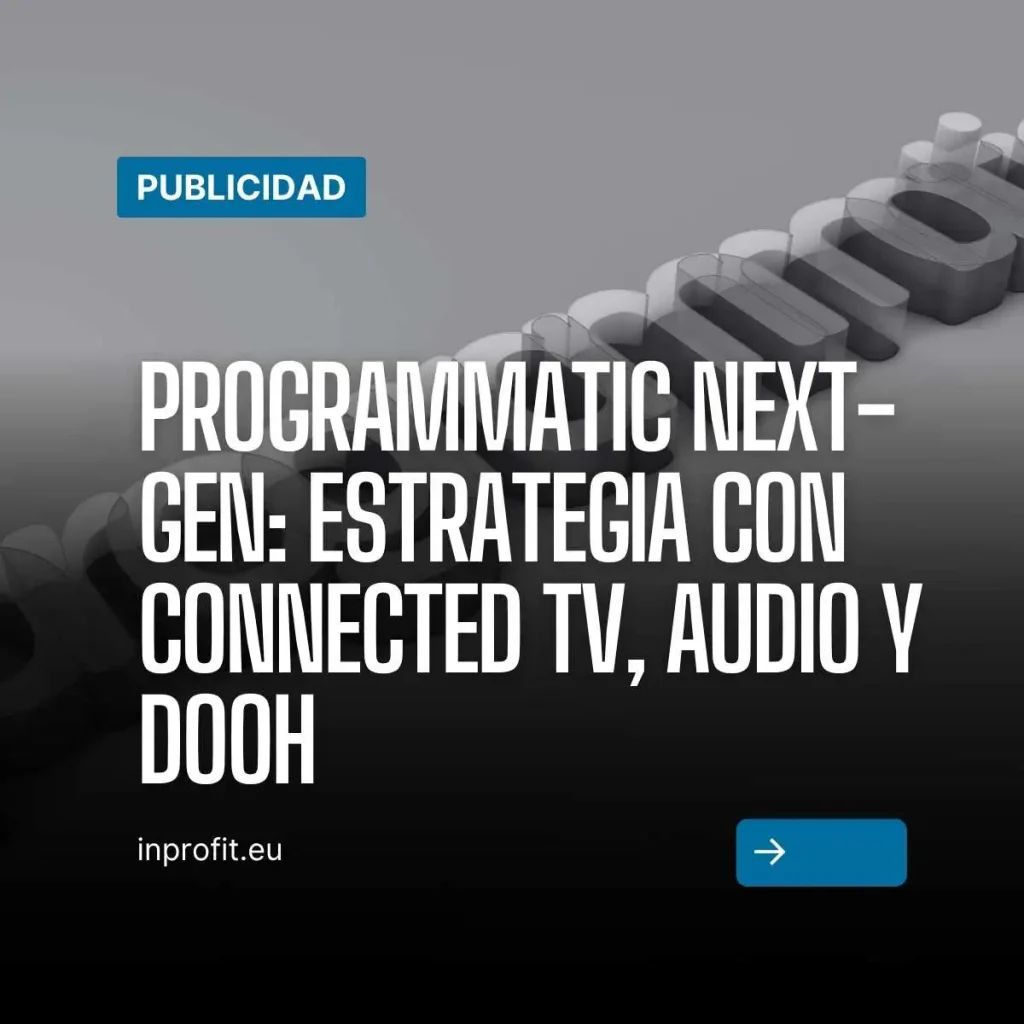Programmatic advertising is entering a transformative era known as Programmatic Next-Gen, where automated digital media buying is merging with disruptive technologies such as contextual artificial intelligence, hyper-segmentation and multichannel integration.
In this new paradigm, Connected TV (CTV), Programmatic Audio and Digital Out-of-Home (DOOH) emerge as pillars to connect with audiences in a fragmented ecosystem.
Programmatic Next-Gen What’s coming?
Programmatic Next-Gen transcends traditional automation by incorporating:
- Advanced Contextual AI: Algorithms that interpret the emotional and situational context of users, beyond cookies or demographic data.
- Holistic Integration: Campaigns that flow between physical and digital channels, creating immersive experiences.
- Digital Sustainability: Prioritizing platforms with reduced carbon footprints and ethical messaging.
Consumers expect not only personalized ads, but experiences that align with their values and contexts. CTV, Audio and DOOH are the ideal channels to deliver on this promise, and here’s how to integrate them in innovative ways.
Connected TV (CTV): Immersive Narratives in the Home
CTV redefines streaming advertising by providing an environment where ads are integrated into premium entertainment experiences, such as Hulu, Amazon Prime or emerging FAST (Free Ad-Supported Streaming TV) platforms. CTV will lead with its ability to combine cinematic storytelling with granular targeting.
Unique strategies for CTV:
- Interactive Narrative Ads: Use emerging formats such as “Story-Choose Ads,” where users influence the ad’s narrative through voice or remote control options. For example, a beverage brand may allow the viewer to choose the flavor that stars in the ad.
- Micro-moment segmentationLeverages AI to identify “micro-moments” in content (e.g., a romantic scene in an energy drink during a streaming game). Platforms such as VideoAmp offer this hyper-segmentation.
- Home AR integration: Smart TVs will enable smartphone-enabled augmented reality (AR) CTV ads, such as virtually testing an advertised piece of furniture in your living room.
- Sustainability in CTV: Prioritizes DSPs that use energy-efficient servers and promote green messages, responding to environmentally conscious audiences.
Innovation case: A fashion brand launches a CTV ad during a reality show, where viewers can “choose” the style of a contestant. At the end, an AR code allows to try the outfits at home, increasing engagement by 30%.
2. Programmatic Audio: Emotional Connections in Movement
The programmatic audio is redefining advertising on Spotify, Audible, podcasts and digital radio. Audio stands out for its ability to emotionally connect with audiences in intimate contexts, such as morning commutes or gym sessions, without the visual saturation of other channels.
Innovative strategies for Audio:
- Ads by emotional state: Uses AI to detect the user’s mood based on the type of content (e.g., “Relaxation” vs. “Motivation” playlists). A wellness brand may advertise guided meditations on calm playlists.
- Immersive 3D audio: Leverage spatial audio formats on platforms like Spotify to create immersive ads that simulate real experiences, such as the sound of a coffee shop for a coffee brand.
- Synchronization with wearables: Integrate data from devices such as smartwatches to personalize ads. For example, an ad for isotonic beverages appears when a user completes a workout recorded on their watch.
- Serialized narratives: Create mini-series of audio announcements that evolve with each listen, encouraging users to follow the story in different episodes of a podcast.
Innovation case: A snack brand launches a series of comedy podcast ads, where each episode features a “flavor mystery” that listeners solve by visiting the website, generating 25% more traffic.
3. Digital Out-of-Home (DOOH): Bridges between the physical and the digital
DOOH transforms outdoor advertising with dynamic digital displays in airports, shopping malls and train stations. DOOH is positioned as a key channel for Programmatic Next-Gen thanks to its flexibility and ability to integrate with the physical world.
Unique strategies for DOOH:
- Environment-reactive ads: Use IoT sensors to adapt DOOH ads according to variables such as traffic, temperature or density of people. For example, an ice cream brand displays refreshing ads on hot days.
- Urban Gamification: Implements interactive games on DOOH screens, such as a 10-second challenge that passersby play via smartphone, earning instant discounts.
- DOOH connected with CTV and Audio: Create campaigns that “follow” the user. For example, a DOOH ad in a train station invites to scan a QR, which triggers an audio ad on Spotify and retargeting on CTV that night.
- Visual ethics: Design DOOH ads with low light contrast to reduce visual pollution, aligning with urban regulations and sustainability values.
Innovation case: A technology brand displays a DOOH game in Times Square, where users solve a puzzle by scanning a QR. Participants receive an audio ad in their music app and a CTV ad at home, generating 1,500 leads in one week.
Building an omnichannel strategy with Programmatic Next-Gen
For CTV, Audio and DOOH to work in harmony, adopt an omnichannel approach that connects consumer touch points:
- Awareness (CTV): Use CTV to introduce the brand with immersive storytelling during streaming events, such as a live concert.
- Engagement (Audio): Reinforce the message with personalized audio announcements at high-attention moments, such as during a podcast.
- Action (DOOH): Close the loop with DOOH in strategic locations, incentivizing visits to stores or websites with QR codes or discounts.
- Retention: Retain exposed users with synchronized CTV and audio ads, creating a seamless experience.
Steps to implement the strategy:
- Select a futuristic DSP: Platforms such as Amobee or Xandr (with enhanced AI) allow you to manage CTV, Audio and DOOH inventories with unified segmentation.
- Centralize data with CDPUse a Customer Data Platform (CDP) such as Segment to integrate audience data and ensure consistent messaging.
- Create transmedia narratives: Design campaigns where each channel tells a part of the story, encouraging users to interact on multiple platforms.
- Measure with hybrid metrics: Combine traditional KPIs (impressions, clicks) with innovative metrics, such as “emotional engagement” (measured via AI) or “footfall attribution” for DOOH.
Benefits of this integration
- Immersive experiences: Consumers feel part of a narrative, not just viewers of ads.
- Blocking resilience: CTV, Audio and DOOH evade ad blockers, ensuring viewability.
- Measurable impact: Omni-channel campaigns generate up to 3 times more ROI than single-channel campaigns, according to projected trends.
- Alignment with values: Prioritizing sustainability and ethics improves brand perception among 70% of consumers.
Programmatic advertising
Programmatic Next-Gen represents a disruptive evolution of programmatic advertising, integrating contextual artificial intelligence, hyper-targeting and omnichannel approaches to connect with audiences through Connected TV (CTV), Programmatic Audio and Digital Out-of-Home (DOOH).
This paradigm leverages advanced technologies such as AI algorithms that analyze emotional and situational context, immersive formats such as interactive narrative ads, 3D audio and urban gamification, and digital sustainability strategies that prioritize low environmental impact platforms.
The integration of these channels, supported by advanced DSPs such as Amobee or Xandr and CDPs such as Segment, allows the creation of coherent transmedia campaigns that maximize engagement, avoid ad blockers and generate up to three times more ROI.
Hybrid metrics, such as emotional engagement and footfall attribution, along with personalized and ethical storytelling, ensure immersive experiences aligned with consumer values. This approach not only optimizes viewability and impact, but also positions brands as leaders in a fragmented and constantly evolving advertising ecosystem.
If you want to know more disruptive digital advertising solutions, contact our agency.




